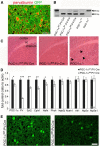PGC-1α provides a transcriptional framework for synchronous neurotransmitter release from parvalbumin-positive interneurons
- PMID: 25339750
- PMCID: PMC4205559
- DOI: 10.1523/JNEUROSCI.1222-14.2014
PGC-1α provides a transcriptional framework for synchronous neurotransmitter release from parvalbumin-positive interneurons
Abstract
Accumulating evidence strongly implicates the transcriptional coactivator peroxisome proliferator-activated receptor γ coactivator 1α (PGC-1α) in the pathophysiology of multiple neurological disorders, but the downstream gene targets of PGC-1α in the brain have remained enigmatic. Previous data demonstrate that PGC-1α is primarily concentrated in inhibitory neurons and that PGC-1α is required for the expression of the interneuron-specific Ca(2+)-binding protein parvalbumin (PV) throughout the cortex. To identify other possible transcriptional targets of PGC-1α in neural tissue, we conducted a microarray on neuroblastoma cells overexpressing PGC-1α, mined results for genes with physiological relevance to interneurons, and measured cortical gene and protein expression of these genes in mice with underexpression and overexpression of PGC-1α. We observed bidirectional regulation of novel PGC-1α-dependent transcripts spanning synaptic [synaptotagmin 2 (Syt2) and complexin 1 (Cplx1)], structural [neurofilament heavy chain (Nefh)], and metabolic [neutral cholesterol ester hydrolase 1 (Nceh1), adenylate kinase 1 (Ak1), inositol polyphosphate 5-phosphatase J (Inpp5j), ATP synthase mitochondrial F1 complex O subunit (Atp5o), phytanol-CoA-2hydroxylase (Phyh), and ATP synthase mitrochondrial F1 complex α subunit 1 (Atp5a1)] functions. The neuron-specific genes Syt2, Cplx1, and Nefh were developmentally upregulated in an expression pattern consistent with that of PGC-1α and were expressed in cortical interneurons. Conditional deletion of PGC-1α in PV-positive neurons significantly decreased cortical transcript expression of these genes, promoted asynchronous GABA release, and impaired long-term memory. Collectively, these data demonstrate that PGC-1α is required for normal PV-positive interneuron function and that loss of PGC-1α in this interneuron subpopulation could contribute to cortical dysfunction in disease states.
Keywords: Barnes maze; Huntington disease; cortical development; ppargc1a; schizophrenia; strontium.
Copyright © 2014 the authors 0270-6474/14/3414375-13$15.00/0.
Figures








Similar articles
-
PV-specific loss of the transcriptional coactivator PGC-1α slows down the evolution of epileptic activity in an acute ictogenic model.J Neurophysiol. 2022 Jan 1;127(1):86-98. doi: 10.1152/jn.00295.2021. Epub 2021 Nov 17. J Neurophysiol. 2022. PMID: 34788174 Free PMC article.
-
Mice lacking the transcriptional coactivator PGC-1α exhibit alterations in inhibitory synaptic transmission in the motor cortex.Neuroscience. 2014 Jun 20;271:137-48. doi: 10.1016/j.neuroscience.2014.04.023. Epub 2014 Apr 24. Neuroscience. 2014. PMID: 24769433 Free PMC article.
-
Parvalbumin deficiency and GABAergic dysfunction in mice lacking PGC-1alpha.J Neurosci. 2010 May 26;30(21):7227-35. doi: 10.1523/JNEUROSCI.0698-10.2010. J Neurosci. 2010. PMID: 20505089 Free PMC article.
-
Cortical PGC-1α-Dependent Transcripts Are Reduced in Postmortem Tissue From Patients With Schizophrenia.Schizophr Bull. 2016 Jul;42(4):1009-17. doi: 10.1093/schbul/sbv184. Epub 2015 Dec 17. Schizophr Bull. 2016. PMID: 26683626 Free PMC article.
-
Dysregulation of PGC-1α-Dependent Transcriptional Programs in Neurological and Developmental Disorders: Therapeutic Challenges and Opportunities.Cells. 2021 Feb 9;10(2):352. doi: 10.3390/cells10020352. Cells. 2021. PMID: 33572179 Free PMC article. Review.
Cited by
-
Hippocampal PGC-1α-mediated positive effects on parvalbumin interneurons are required for the antidepressant effects of running exercise.Transl Psychiatry. 2021 Apr 15;11(1):222. doi: 10.1038/s41398-021-01339-1. Transl Psychiatry. 2021. PMID: 33859158 Free PMC article.
-
Study insights in the role of PGC-1α in neurological diseases: mechanisms and therapeutic potential.Front Aging Neurosci. 2025 Feb 12;16:1454735. doi: 10.3389/fnagi.2024.1454735. eCollection 2024. Front Aging Neurosci. 2025. PMID: 40012862 Free PMC article. Review.
-
Aging-associated decrease of PGC-1α promotes pain chronification.Aging Cell. 2024 Aug;23(8):e14177. doi: 10.1111/acel.14177. Epub 2024 May 17. Aging Cell. 2024. PMID: 38760908 Free PMC article.
-
Fate plasticity of interneuron specification.iScience. 2025 Mar 27;28(4):112295. doi: 10.1016/j.isci.2025.112295. eCollection 2025 Apr 18. iScience. 2025. PMID: 40264797 Free PMC article.
-
PV-specific loss of the transcriptional coactivator PGC-1α slows down the evolution of epileptic activity in an acute ictogenic model.J Neurophysiol. 2022 Jan 1;127(1):86-98. doi: 10.1152/jn.00295.2021. Epub 2021 Nov 17. J Neurophysiol. 2022. PMID: 34788174 Free PMC article.
References
-
- Alcántara S, Ferrer I, Soriano E. Postnatal development of parvalbumin and calbindin D28K immunoreactivities in the cerebral cortex of the rat. Anat Embryol. 1993;188:63–73. - PubMed
-
- Behrends JC, ten Bruggencate G. Changes in quantal size distributions upon experimental variations in the probability of release at striatal inhibitory synapses. J Neurophysiol. 1998;79:2999–3011. - PubMed
Publication types
MeSH terms
Substances
Grants and funding
LinkOut - more resources
Full Text Sources
Other Literature Sources
Molecular Biology Databases
Research Materials
Miscellaneous
